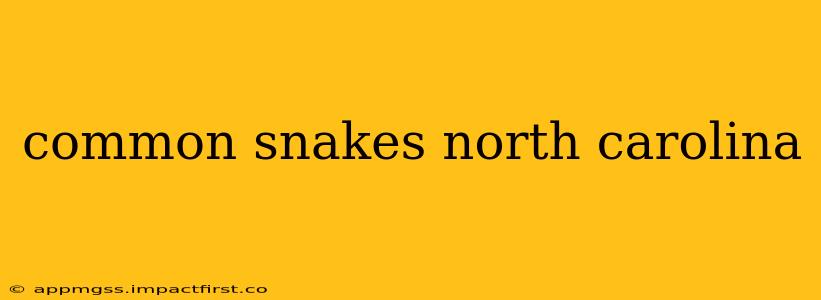North Carolina boasts a diverse range of snake species, from harmless garter snakes to venomous copperheads. Understanding which snakes are common in the state, how to identify them, and how to react when encountering one is crucial for both safety and appreciating North Carolina's natural biodiversity. This guide will explore some of the most frequently encountered snakes in North Carolina, addressing common questions and concerns.
What are some common harmless snakes in North Carolina?
Many snakes in North Carolina are completely harmless to humans. These often-misunderstood reptiles play a vital role in the ecosystem, controlling rodent populations and contributing to ecological balance. Some of the most common harmless snakes you might encounter include:
-
Black Rat Snake: A large, powerful constrictor, often mistaken for a venomous snake due to its size and coloration. They're typically black or dark gray, but younger snakes may have lighter markings. They are beneficial, preying on rodents and other pests.
-
Corn Snake: These attractive snakes are popular in the pet trade due to their vibrant colors and docile nature. Wild corn snakes in North Carolina are typically reddish-brown with darker blotches.
-
Eastern Garter Snake: These slender snakes are often found near water sources. They are highly variable in color, ranging from brown and olive to green and even reddish. They are relatively small and easily identifiable by their three longitudinal stripes.
-
Northern Brown Snake: These shy snakes are often overlooked due to their cryptic coloration, blending seamlessly into leaf litter and soil. They are typically brown, with a darker brown or black stripe running down their back.
-
Eastern Hog-nosed Snake: Known for their impressive bluff display, these snakes will flatten their heads and hiss aggressively when threatened, sometimes even feigning death. They are harmless but their dramatic behavior can be quite startling.
What are some common venomous snakes in North Carolina?
While most snakes in North Carolina are non-venomous, encountering a venomous species requires caution and awareness. The most common venomous snakes include:
-
Copperhead: These snakes are characterized by their copper-colored heads and hourglass-shaped markings along their bodies. They prefer wooded areas and are often found near rocks and logs. Their venom is hemotoxic, affecting blood clotting.
-
Cottonmouth (Water Moccasin): These semi-aquatic snakes are found near swamps, rivers, and other water bodies. They are relatively large and have a distinctive dark band along their jaw. They possess highly toxic venom.
-
Timber Rattlesnake: One of the largest venomous snakes in North Carolina, the timber rattlesnake is easily identifiable by its large size, distinctive rattles, and dark brown or black crossbands on a tan or gray background. Its venom is also hemotoxic.
How can I identify a snake I've seen in North Carolina?
Identifying snakes can be challenging, and it's crucial to exercise caution. Avoid attempting to handle any snake you encounter. Utilize resources like field guides, online databases (with caution, as online images can sometimes be misidentified), and local herpetological societies to aid in identification. Paying close attention to the snake's size, shape, color patterns, and habitat can significantly improve your chances of accurate identification. Photography can also be helpful in getting expert assistance for identification.
What should I do if I encounter a snake in North Carolina?
The best course of action when encountering a snake is to leave it alone. Give the snake ample space, and avoid sudden movements that might startle it. If you're near a home or building, it's best to slowly move away, keeping your eyes on the snake but avoiding direct confrontation. If bitten by a venomous snake, seek immediate medical attention.
Are there any resources available to help me identify North Carolina snakes?
Yes, several resources can assist in identifying North Carolina snakes. Local herpetological societies, natural history museums, and universities often have experts who can help with identification if you provide clear photographs or detailed descriptions. Reputable field guides specific to the region are also invaluable resources. Remember to always prioritize safety and avoid handling unknown snakes.
This guide provides a starting point for understanding common snakes in North Carolina. Remember that responsible wildlife observation and a healthy respect for all animals are key to coexisting peacefully within our shared environment.
